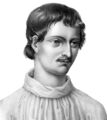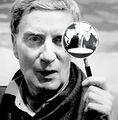Template:Selected anniversaries/January 27: Difference between revisions
No edit summary |
No edit summary |
||
| Line 1: | Line 1: | ||
<gallery> | <gallery> | ||
||AD 98 | ||AD 98: Trajan succeeds his adoptive father Nerva as Roman emperor; under his rule the Roman Empire would reach its maximum extent. | ||
||1302 | ||1302: Dante Alighieri is exiled from Florence. | ||
||1343 | ||1343: Pope Clement VI issues the papal bull ''Unigenitus'' to justify the power of the pope and the use of indulgences. Nearly 200 years later, Martin Luther would protest this. | ||
File:Giordano Bruno.jpg|link=Giordano Bruno (nonfiction)|1593: The Vatican opens the seven-year trial of scholar [[Giordano Bruno (nonfiction)|Giordano Bruno]]. He will be burned at the stake. | File:Giordano Bruno.jpg|link=Giordano Bruno (nonfiction)|1593: The Vatican opens the seven-year trial of scholar [[Giordano Bruno (nonfiction)|Giordano Bruno]]. He will be burned at the stake. | ||
John_Fleming_in_Fleming_tube.jpg|link=John Ambrose Fleming (nonfiction)|1931: Miniaturized version of [[John Ambrose Fleming (nonfiction)|John Ambrose Fleming]] delivers lecture from within Fleming tube. | John_Fleming_in_Fleming_tube.jpg|link=John Ambrose Fleming (nonfiction)|1931: Miniaturized version of [[John Ambrose Fleming (nonfiction)|John Ambrose Fleming]] delivers lecture from within Fleming tube. | ||
||1596 | ||1596: Francis Drake dies ... captain and explorer. | ||
||1687 | ||1687: Johann Balthasar Neumann born ... engineer and architect, designed Würzburg Residence and Basilica of the Fourteen Holy Helpers. | ||
||1731 | ||1731: Bartolomeo Cristofori dies ... instrument maker, invented the Piano. | ||
||1785 | ||1785: The University of Georgia is founded, the first public university in the United States. | ||
||1795 | ||1795: Eli Whitney Blake born ... engineer, invented the Mortise lock. | ||
||Charles Hutton | ||1823: Charles Hutton dies ... mathematician and surveyor. He was professor of mathematics at the Royal Military Academy, Woolwich from 1773 to 1807. He is remembered for his calculation of the density of the earth from Nevil Maskelyne's observations on Schiehallion. | ||
File:Lewis Carroll.jpg|link=Lewis Carroll (nonfiction)|1832: Novelist, poet, and mathematician [[Lewis Carroll (nonfiction)|Lewis Carroll]] born. He will write ''Alice's Adventures in Wonderland'', and its sequel ''Through the Looking-Glass''. | File:Lewis Carroll.jpg|link=Lewis Carroll (nonfiction)|1832: Novelist, poet, and mathematician [[Lewis Carroll (nonfiction)|Lewis Carroll]] born. He will write ''Alice's Adventures in Wonderland'', and its sequel ''Through the Looking-Glass''. | ||
| Line 25: | Line 25: | ||
File:János Bolyai.jpg|link=János Bolyai (nonfiction)|1860: Mathematician and academic [[János Bolyai (nonfiction)|János Bolyai]] dies. He was one of the founders of non-Euclidean geometry. | File:János Bolyai.jpg|link=János Bolyai (nonfiction)|1860: Mathematician and academic [[János Bolyai (nonfiction)|János Bolyai]] dies. He was one of the founders of non-Euclidean geometry. | ||
||Heinrich Rose | ||1864: Heinrich Rose dies ... mineralogist and analytical chemist. | ||
||Adam Sedgwick (d. 27 January 1873) was a British geologist, one of the founders of modern geology. He proposed the Devonian period of the geological timescale. | ||Adam Sedgwick (d. 27 January 1873) was a British geologist, one of the founders of modern geology. He proposed the Devonian period of the geological timescale. | ||
||1880 | File:Thomas Edison.jpg|link=Thomas Edison (nonfiction)|1880: [[Thomas Edison (nonfiction)|Thomas Edison]] receives the patent on the incandescent lamp. | ||
|| | ||1887: Carl Blegen born ... archaeologist who unearthed evidence that supported and dated the sack of Troy recorded in Homer's Iliad. Storage jars, skeletons and ash piles (which he interpreted as evidence of the city's fiery destruction) reinforced his conviction. He also discovered, in 1939, clay tablets dating from about 1250 BC. At the fabled palace of King Nestor, a major figure in the Trojan War, nearly 1,100 clay tablet records of palace transactions were found there over 15 years. These were inscribed with the earliest known examples of European writing, enabling cryptographers to find the key by which the ancient tablets could be decoded, proving the existence of a Greek civilization where none was formerly thought to exist. Pic. | ||
|| | ||1889: Balthasar van der Pol born ... physicist and academic. Pic. | ||
|| | ||1895: James Cockle dies ... lawyer and mathematician. He invented the number systems of tessarines and coquaternions, and worked with Arthur Cayley on the theory of linear algebra. Pic. | ||
|| | ||1898: Erich Ernest Zepler born ... electronics expert and chess problem composer. Pic. | ||
|| | ||1903: Howard Percy "Bob" Robertson born ... mathematician and physicist known for contributions related to physical cosmology and the uncertainty principle. | ||
|| | ||1903: John Carew Eccles born ... neurophysiologist and philosopher who won the 1963 Nobel Prize in Physiology or Medicine for his work on the synapse. He shared the prize with Andrew Huxley and Alan Lloyd Hodgkin. | ||
||1912 | ||1912: Arne Næss born ... philosopher and environmentalist. | ||
|| | ||1912: Francis Rogallo born ... engineer, invented the Rogallo wing. | ||
|| | ||1924: Johannes Frischauf dies ... mathematician, physicist, astronomer, geodesist and alpinist. | ||
|| | ||1928: Leo Breiman born ... statistician. His work helped to bridge the gap between statistics and computer science, particularly in the field of machine learning. His most important contributions were his work on classification and regression trees and ensembles of trees fit to bootstrap samples. Pic. | ||
||James Victor Uspensky | ||1941: Beatrice Tinsley born ... astronomer and cosmologist. | ||
||1947: James Victor Uspensky dies ... mathematician notable for writing ''Theory of Equations''. | |||
File:Nikolai Luzin stamp.jpg|link=Nikolai Luzin (nonfiction)|1948: Mathematician, theorist, and crime-fighter [[Nikolai Luzin (nonfiction)|Nikolai Luzin]] uses point-set topology to detect and prevent [[crimes against mathematical constants]]. | File:Nikolai Luzin stamp.jpg|link=Nikolai Luzin (nonfiction)|1948: Mathematician, theorist, and crime-fighter [[Nikolai Luzin (nonfiction)|Nikolai Luzin]] uses point-set topology to detect and prevent [[crimes against mathematical constants]]. | ||
||1951 | ||1951: Nuclear testing at the Nevada Test Site begins with Operation Ranger. | ||
||1961 | ||1961: The Soviet submarine S-80 sinks when its snorkel malfunctions, flooding the boat. | ||
||1967 | ||1967: Astronauts Gus Grissom, Edward White and Roger Chaffee are killed in a fire during a test of their Apollo 1 spacecraft at the Kennedy Space Center, Florida. | ||
||1967 | ||1967: United States, United Kingdom, and Soviet Union sign the Outer Space Treaty in Washington, D.C., banning deployment of nuclear weapons in space, and limiting use of the Moon and other celestial bodies to peaceful purposes. | ||
File:Richard Courant.jpg|link=Richard Courant (nonfiction)|1972: Mathematician [[Richard Courant (nonfiction)|Richard Courant]] dies. He co-wrote ''What is Mathematics?''. | File:Richard Courant.jpg|link=Richard Courant (nonfiction)|1972: Mathematician [[Richard Courant (nonfiction)|Richard Courant]] dies. He co-wrote ''What is Mathematics?''. | ||
| Line 67: | Line 69: | ||
File:Brion Gysin scrying engine Dreamachine.jpg|link=Brion Gysin|1972: [[Brion Gysin]] uses hand-held [[scrying engine]] to counteract the effects of crimes against [[Poem|poetry]]. | File:Brion Gysin scrying engine Dreamachine.jpg|link=Brion Gysin|1972: [[Brion Gysin]] uses hand-held [[scrying engine]] to counteract the effects of crimes against [[Poem|poetry]]. | ||
||1973 | ||1973: The Paris Peace Accords officially end the Vietnam War. Colonel William Nolde is killed in action becoming the conflict's last recorded American combat casualty. | ||
| | ||1995: Raphael Mitchel Robinson dies ... mathematician. He will work on mathematical logic, set theory, geometry, number theory, and combinatorics. Pic. | ||
File:Howard Zinn 2009.jpg|link=Howard Zinn (nonfiction)|2010: Historian, playwright, and social activist [[Howard Zinn (nonfiction)|Howard Zinn]] dies. He wrote extensively about the civil rights and anti-war movements, and labor history of the United States. | File:Howard Zinn 2009.jpg|link=Howard Zinn (nonfiction)|2010: Historian, playwright, and social activist [[Howard Zinn (nonfiction)|Howard Zinn]] dies. He wrote extensively about the civil rights and anti-war movements, and labor history of the United States. | ||
||2015 | ||2015: Charles Hard Townes dies ... physicist and academic, Nobel Prize laureate. | ||
||2017 | ||2017: Arthur H. Rosenfeld dies ... physicist. Pic. | ||
File:Green_Spiral_9.jpg|link=Green Spiral 9 (nonfiction)|2017: Steganographic analysis of ''[[Green Spiral 9 (nonfiction)|Green Spiral 9]]'' unexpectedly reveals "more than a terabyte" of previously unknown [[Gnomon algorithm functions]]. | File:Green_Spiral_9.jpg|link=Green Spiral 9 (nonfiction)|2017: Steganographic analysis of ''[[Green Spiral 9 (nonfiction)|Green Spiral 9]]'' unexpectedly reveals "more than a terabyte" of previously unknown [[Gnomon algorithm functions]]. | ||
</gallery> | </gallery> | ||
Revision as of 18:19, 17 August 2018
1593: The Vatican opens the seven-year trial of scholar Giordano Bruno. He will be burned at the stake.
1931: Miniaturized version of John Ambrose Fleming delivers lecture from within Fleming tube.
1832: Novelist, poet, and mathematician Lewis Carroll born. He will write Alice's Adventures in Wonderland, and its sequel Through the Looking-Glass.
1860: Mathematician and academic János Bolyai dies. He was one of the founders of non-Euclidean geometry.
1880: Thomas Edison receives the patent on the incandescent lamp.
1948: Mathematician, theorist, and crime-fighter Nikolai Luzin uses point-set topology to detect and prevent crimes against mathematical constants.
1972: Mathematician Richard Courant dies. He co-wrote What is Mathematics?.
1972: Brion Gysin uses hand-held scrying engine to counteract the effects of crimes against poetry.
2010: Historian, playwright, and social activist Howard Zinn dies. He wrote extensively about the civil rights and anti-war movements, and labor history of the United States.
2017: Steganographic analysis of Green Spiral 9 unexpectedly reveals "more than a terabyte" of previously unknown Gnomon algorithm functions.









